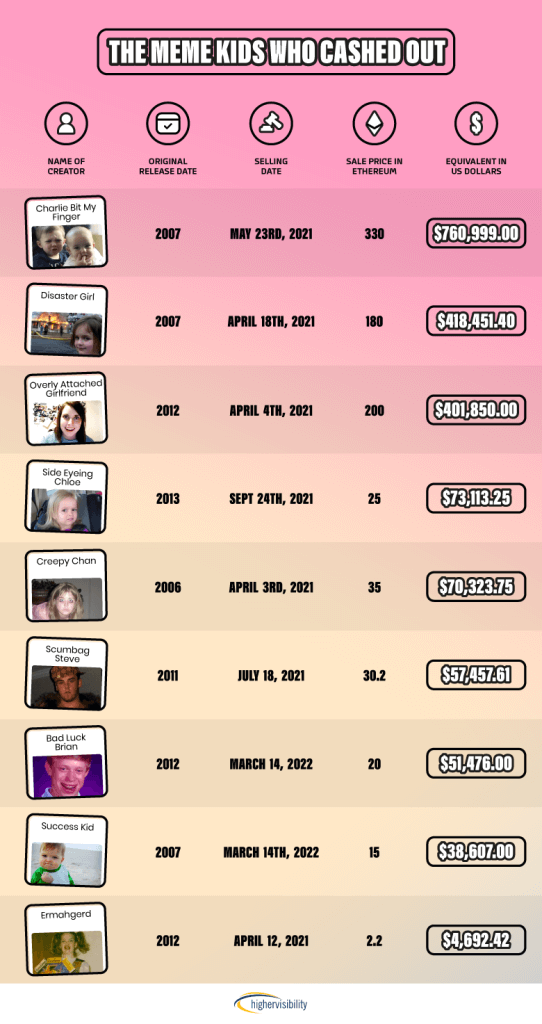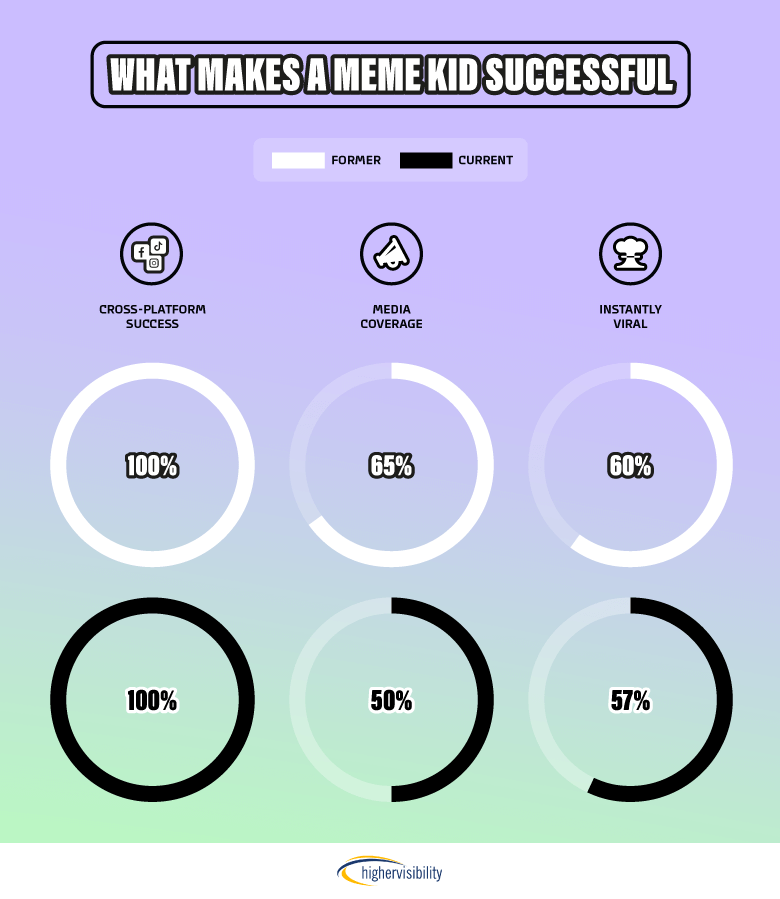Is the Age of the Meme Kid Over?
Key Takeaways
- Original meme kids like 'Disaster Girl' and 'Charlie Bit My Finger' from 2007 to 'Ermahgerd' in 2012 have gained immense value as NFTs, showcasing the profitable nature of internet culture icons.
- Nostalgia plays a significant role in the success of meme kids' NFTs, with nearly all successful NFTs originating in 2012 or earlier, raising questions on the impact of nostalgia on such digital assets.
- In the NFT rush of 2021, 7 out of 9 meme kids' NFTs were sold, reflecting a growing interest in preserving internet culture through unique digital representations.
The original ‘meme kid era’ began during the early stages of social media and stems from images like ‘Disaster Girl’ and ‘Charlie Bit My Finger’ from 2007, all the way through to ones like ‘Ermahgerd’ in 2012. These images became so iconic in terms of internet culture that they’ve recently sold as non-fungible tokens (NFTs), generating a massive profit for these kids that just so happened to go viral.
As such, HigherVisibility wanted to examine the meme kids that cashed out from their NFT equivalent, those that created NFTs but remain unsold, as well as those that didn’t make an NFT to find out what underpins meme kid success and use these metrics to predict, which, if any of the recent meme kids in our study, could go on to see NFT success.

Ultimately, the value of the NFT is decided by the buyer, and as these sales show, the original meme kids have been deemed a key part of internet culture. When it came to NFTs of meme kids that sold, all except one originated in 2012 and earlier, which perhaps begs the question, is a certain degree of nostalgia necessary for a meme kid to be successful in NFT format?
During the NFT rush of 2021, 7 out of 9 of these memes sold in NFT format, with the remaining 2 being sold in 2022. While some fear that NFTs will lose their shine, others remain positive that as we move further into web 3.0, these unique representations of a piece of internet culture, will increase in popularity. 3F Music, a Dubai-based music company, notoriously has a monopoly over many high-value NFTs, particularly those in the Meme space. Farzin Fard’s portfolio includes the most valuable NFTs like Charlie Bit My Finger, Disaster Girl, Side Eyeing Chloe, Overly Attached Girlfriend, and Creepy Chan.
The most valuable meme of all time so far was Charlie Bit My Finger. The NFT sold for 330 Ethereum, the equivalent of around $760,999 to 3F Music, more than the average cost of a Lamborghini, with the parents of the children offering to remove the original clip from YouTube to increase profitability. Before going viral, it was originally set as a private video on YouTube for family and friends but was then made public, remaining largely undiscovered for several months until enactment parodies began surfacing on the platform, it was then featured on CollegeHumor which resulted in further spread. By early February 2008, the video reached 2.6 million views, jumping to 12 million views as of March of the same year. As of 2017, it has over 849 million views, making it the fourth most-viewed video in the non-music category.
In the second position, is Disaster Girl. The NFT sold for 180 Ethereum, approximately $418,451.40 at the point of sale, the equivalent of 26 years of rent in the average US apartment (February 2022). The original image was uploaded to Zoomr but didn’t receive much attention until it was submitted to JPG Magazine later in the year for an “Emotion Capture” competition, by November 2008 this had gained over 95,000 views. This was then posted by Buzzfeed, along with Digg and Trend World. Over the years derivatives have been mentioned on the likes of the Huffington Post and Cracked. Searches for Disaster Girl began in October 2008, and peaked in May 2011, which shows how its virality was staggered.
The difference in the prices fetched between the top few NFTs and the others in the list is also reflective of their extent of virality and permeation into internet culture. Those at the top had their cultural moment, while the ones toward the bottom of the list are memorable, but didn’t have the same kind of cultural chokehold that the others had. Understanding why something goes viral is notoriously difficult, however, by drawing comparisons between the former meme kids like those mentioned above, who have already been deemed successful in terms of their contribution to internet culture, and the meme kids that we’ve seen rise recently, it’s possible to predict somewhat whether the age of the meme kid is over, or whether it will continue to progress.
Meanwhile, there were also several memes that achieved a level of virality, available as NFTs but remaining unsold. These include Gavin Thomas, who took the internet by storm, albeit later than the original meme kids, but also not recent enough to be considered in the same vein as current memes. He first appeared on his uncle, Nick Mastodon’s Vine account. In 2014 he uploaded a compilation of Gavin’s vines to YouTube which accumulated over 50,000 views by 2016. The memes were picked up by The Daily Dot, Smosh, and Entertainment Weekly and were retweeted by celebrities like Katy Perry. Based on our study, meme kids that originated past 2013, didn’t see the same flurry of excitement when they released NFT versions of the meme, whether they went viral or not.
Similarly, there are memes that could have potentially seen NFT success, had they been released as an NFT. For example, the video of a child receiving an avocado for Christmas from his parents as a lesson in being grateful for presents even if they might not be exactly what they wished for. The video of the child exclaiming “it’s an avocado, thanks!” originated on Vine and achieved 123.4 million loops, 655k likes, and 321k revines, as well as re-uploads and compilations on YouTube. It further attracted celebrity attention, with Demi Lovato face-timing the child. It achieved wider media coverage in The Daily Dot, Today, and Daily Mail as people began buying people avocados for Christmas. The phrase is now synonymous with receiving something you didn’t want, for those who are aware of the original meme.
Given the nostalgia of the meme, the cultural moment it had, and the longevity in terms of references amongst older gen Zs and millennials, the image could’ve also made a profit as a collectible within the internet culture sphere.

When we analyze some of the most viral meme kids of the past couple of years, it’s clear that while they are a part of internet culture, they perhaps don’t have the same impact as former meme kids, or we won’t see them have success as NFTs until there’s an element of nostalgia to the images or a pivotal shift in internet culture. Given how new TikTok is as a platform, there could be room for NFT images to be developed off the back of culture that originates there, especially seeing how some of the most profitable memes rose in the early days of modern social media. The caveat to this is that social media is becoming an increasingly competitive space with a high turnover of trending content and new creators, perhaps making it more difficult for a meme kid to rise in an original, pioneering way.
When it comes to the meme kids of our time, 2018 saw the rise of the Walmart Yodel Boy, also known as Mason Ramsey. A video of a boy yodeling in Walmart was originally posted to YouTube, where a Twitter repost then gained over 49,000 retweets and 167,000 likes, this then sparked further uses within the platform. The song he sang, ‘Lovesick Blues’ by Hank Williams saw a two-week increase of 2452% in streams on Spotify, with the US Viral 50 chart ranking the song as number 3 off the back of the video, and number 4 globally. He then appeared on The Ellen Degeneres Show where his performance there became the top trending video on YouTube. He launched his music career by appearing at the Grand Ole Opry and Coachella before being signed by Atlantic Records and Big Loud.
More recently in 2022, we saw a young child proclaiming his love for corn. Referred to as simply the “It’s Corn, Kid,” his real name, Tariq. The video was originally posted to YouTube and TikTok as a sporadic interview with Recess Therapy and instantly went viral, receiving 10 million views and 252,000 likes, with snippets being turned into a parody song across both platforms. The meme has achieved a slew of coverage across publications like The Guardian, NBC News, Insider, and Mashable due to the popularity of the clip across social media, and the sweet nature of the child explaining just why he loves corn so much.
So, is the age of the meme kid over? While the prices that former memes were sold for indicate the extent of their virality, and their importance in shaping internet culture, not all memes that went viral have seen the same kind of profitability. It’s not yet clear the direction in which NFTs will go in, or whether current meme kids will develop into NFTs and achieve the same kind of profit. However, the rise of TikTok and the emerging meme culture there, has seen similar shifts in internet culture as we’ve known it and has the potential to launch burgeoning creators and one-hit childhood videos, into the spotlight.
——————————————————————————————————————————-
Methodology
We used Know Your Meme to generate a seed list of some of the most culturally significant and viral meme kids of previous generations. We then used Foundation and Open Sea to discover which were listed as an NFT, when they had been sold, and for how much. We then measured metrics such as cross-platform success, media coverage, and whether the meme went instantly viral to compare with this generation’s meme kids.
